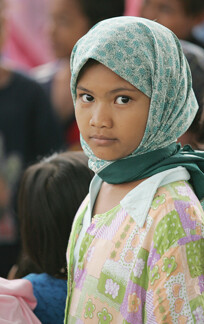
Partnering with the Poor
 As a continuation of the UMConnection's presentation examining the four areas of focus for the 2008 General Conference we look at the third initiative of the Connectional Table: Partnering With the Poor.
As a continuation of the UMConnection's presentation examining the four areas of focus for the 2008 General Conference we look at the third initiative of the Connectional Table: Partnering With the Poor.
Poverty touches us all. In Washington, D.C., for example, a recent report indicates that one in three children in the District lives in poverty.
According to the D.C. Kids Count Collaborative, more than one-third of African-American children live below the poverty level.
This sobering statistic is multiplied in cities and towns across the world.
When it meets in Fort Worth April 23 through May 2, The United Methodist Church will reaffirm its strong unified stance to combat poverty, making it one of the four emphases that will drive the budget and actions of the denomination over the next four years.
Since the issue of poverty is such a wide sweeping problem with many facets, the church has decided to focus its effort on children. It is intended that, through much research and deliberation, six pilot projects will be developed for action during the 2009-2012 quadrennium.
These projects would call for collaboration of United Methodists from around the globe.
According to the World Health Report 2002, "hunger is the number one killer of African children, more than any single disease condition. The simple lack of food, which weakens the immune system, plays a role in more than half of childhood deaths."
The issue in West Africa is that land requires a lot of cultivation and care to produce a stable and sustainable source of food. The technology and resources are simply not available, and as a result shortages make up much of the problem. One in six children die before the age of five years and nearly half of the remaining children are physically stunted.
In the Philippines, a vicious cycle of starvation leading to crime and abuse runs rampant in some of the country's poorest regions. Children suffering from malnutrition are often times manipulated by corrupt factions to take up arms or commit crimes for their causes. When these innocent kids are then arrested for their actions, the situation is even worse, as they are often crammed into small jail cells and treated poorly; void of basic human rights and privileges.
Eastern Europe is an area of the world that often gets overshadowed in terms of poor economic development. Since the fallout of the Soviet Union, many of these European countries have not been able to pick themselves up and are falling deeper into poverty.
According to a 2007 United Nations report, 18 million children under the age of 12, are living on less than $2 a day in the region. Many of these children have resorted to making money any way they can to survive, including begging and prostitution.
 Roughly 64 percent of Honduras' population lives in extreme poverty and much of this demographic is comprised of children. The issue can be traced back to the reality that children must work in order to support their families, especially in the rural areas of the country. This means kids often receive little or no education, because their survival takes immediate precedence to attending school.
Roughly 64 percent of Honduras' population lives in extreme poverty and much of this demographic is comprised of children. The issue can be traced back to the reality that children must work in order to support their families, especially in the rural areas of the country. This means kids often receive little or no education, because their survival takes immediate precedence to attending school.
Even if children do find a way to break the cyclical nature of working the fields, they are not likely to fare much better in the cities, where disease, drugs and gangs all wait to prey on them.
Here in the United States, according to the National Center for Children in Poverty, there are more than 73 million children, 39 percent of whom live in low-income families and another 17 percent of them live in poverty.
After a decade of decline, the proportion of children living in low-income families in the United States is rising again, a trend that began in 2000. This translates into the staggering figure that more than
28 million children have parents who are unable to meet their family's basic needs.
These statistics and figures are meant as a reminder to all of us that this is the world we live in. Fortun-ately, United Methodist leaders say, if there is one thing time has taught us, it is that when a group of people filled with love and passion focus their efforts, anything is possible.
While eliminating poverty seems a daunting task, it is one the 2008 General Conference is committed to as it calls upon the denomination to begin meaningful partnerships with the poor.

Login/Register to leave comment